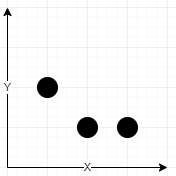| comments | difficulty | edit_url | rating | source | tags | ||
|---|---|---|---|---|---|---|---|
true |
中等 |
1665 |
第 37 场双周赛 Q2 |
|
给你一个数组 towers 和一个整数 radius 。
数组 towers 中包含一些网络信号塔,其中 towers[i] = [xi, yi, qi] 表示第 i 个网络信号塔的坐标是 (xi, yi) 且信号强度参数为 qi 。所有坐标都是在 X-Y 坐标系内的 整数 坐标。两个坐标之间的距离用 欧几里得距离 计算。
整数 radius 表示一个塔 能到达 的 最远距离 。如果一个坐标跟塔的距离在 radius 以内,那么该塔的信号可以到达该坐标。在这个范围以外信号会很微弱,所以 radius 以外的距离该塔是 不能到达的 。
如果第 i 个塔能到达 (x, y) ,那么该塔在此处的信号为 ⌊qi / (1 + d)⌋ ,其中 d 是塔跟此坐标的距离。一个坐标的 信号强度 是所有 能到达 该坐标的塔的信号强度之和。
请你返回数组 [cx, cy] ,表示 信号强度 最大的 整数 坐标点 (cx, cy) 。如果有多个坐标网络信号一样大,请你返回字典序最小的 非负 坐标。
注意:
- 坐标
(x1, y1)字典序比另一个坐标(x2, y2)小,需满足以下条件之一:<ul> <li>要么 <code>x1 < x2</code> ,</li> <li>要么 <code>x1 == x2</code> 且 <code>y1 < y2</code> 。</li> </ul> </li> <li><code>⌊val⌋</code> 表示小于等于 <code>val</code> 的最大整数(向下取整函数)。</li>
示例 1:
输入:towers = [[1,2,5],[2,1,7],[3,1,9]], radius = 2 输出:[2,1] 解释: 坐标 (2, 1) 信号强度之和为 13 - 塔 (2, 1) 强度参数为 7 ,在该点强度为 ⌊7 / (1 + sqrt(0)⌋ = ⌊7⌋ = 7 - 塔 (1, 2) 强度参数为 5 ,在该点强度为 ⌊5 / (1 + sqrt(2)⌋ = ⌊2.07⌋ = 2 - 塔 (3, 1) 强度参数为 9 ,在该点强度为 ⌊9 / (1 + sqrt(1)⌋ = ⌊4.5⌋ = 4 没有别的坐标有更大的信号强度。
示例 2:
输入:towers = [[23,11,21]], radius = 9 输出:[23,11] 解释:由于仅存在一座信号塔,所以塔的位置信号强度最大。
示例 3:
输入:towers = [[1,2,13],[2,1,7],[0,1,9]], radius = 2 输出:[1,2] 解释:坐标 (1, 2) 的信号强度最大。
提示:
1 <= towers.length <= 50towers[i].length == 30 <= xi, yi, qi <= 501 <= radius <= 50
由于坐标点的范围是
时间复杂度
class Solution:
def bestCoordinate(self, towers: List[List[int]], radius: int) -> List[int]:
mx = 0
ans = [0, 0]
for i in range(51):
for j in range(51):
t = 0
for x, y, q in towers:
d = ((x - i) ** 2 + (y - j) ** 2) ** 0.5
if d <= radius:
t += floor(q / (1 + d))
if t > mx:
mx = t
ans = [i, j]
return ansclass Solution {
public int[] bestCoordinate(int[][] towers, int radius) {
int mx = 0;
int[] ans = new int[] {0, 0};
for (int i = 0; i < 51; ++i) {
for (int j = 0; j < 51; ++j) {
int t = 0;
for (var e : towers) {
double d = Math.sqrt((i - e[0]) * (i - e[0]) + (j - e[1]) * (j - e[1]));
if (d <= radius) {
t += Math.floor(e[2] / (1 + d));
}
}
if (mx < t) {
mx = t;
ans = new int[] {i, j};
}
}
}
return ans;
}
}class Solution {
public:
vector<int> bestCoordinate(vector<vector<int>>& towers, int radius) {
int mx = 0;
vector<int> ans = {0, 0};
for (int i = 0; i < 51; ++i) {
for (int j = 0; j < 51; ++j) {
int t = 0;
for (auto& e : towers) {
double d = sqrt((i - e[0]) * (i - e[0]) + (j - e[1]) * (j - e[1]));
if (d <= radius) {
t += floor(e[2] / (1 + d));
}
}
if (mx < t) {
mx = t;
ans = {i, j};
}
}
}
return ans;
}
};func bestCoordinate(towers [][]int, radius int) []int {
ans := []int{0, 0}
mx := 0
for i := 0; i < 51; i++ {
for j := 0; j < 51; j++ {
t := 0
for _, e := range towers {
d := math.Sqrt(float64((i-e[0])*(i-e[0]) + (j-e[1])*(j-e[1])))
if d <= float64(radius) {
t += int(float64(e[2]) / (1 + d))
}
}
if mx < t {
mx = t
ans = []int{i, j}
}
}
}
return ans
}